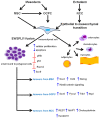Challenges in modeling EWS-FLI1-driven transgenic mouse model for Ewing sarcoma
- PMID: 34956445
- PMCID: PMC8661172
Challenges in modeling EWS-FLI1-driven transgenic mouse model for Ewing sarcoma
Abstract
EWS-FLI1 is a master regulator of Ewing sarcoma (ES) oncogenesis. Although EWS-FLI1 represents a clear therapeutic target, targeted therapeutic inhibitors are lacking. Scientific literature has indicated accumulating information pertaining to EWS-FLI1 translocation, pathogenesis, function, oncogenic partnerships, and potential clinical relevance. However, attempts to develop EWS-FLI1-driven human-like ES mouse models or in vivo systems ended up with limited success. Establishing such models as preclinical screening tools may accelerate the development of EWS-FLI1 targeted therapeutic inhibitors. This review summarizes the current scenario, which focuses on the limitations, challenges, and possible reasons for past failures in model development and also plausible interim alternatives.
Keywords: EWS-FLI1; Ewing sarcoma; fusion protein; mouse models; progenitor cells; tumor cell of origin.
AJTR Copyright © 2021.
Conflict of interest statement
None.
Figures


References
-
- Glass AG, Fraumeni JF. Epidemiology of bone cancer in children. J Natl Cancer Inst. 1970;44:187–199. - PubMed
-
- Ries LG, Smith MA, Gurney JG, Linet M, Tamra T, Young JL, Bunin GR, editors. Cancer incidence and survival among children and adolescents: United States SEER program 1975-1995. National Cancer Institute, SEER Program. 1999
-
- Wang CC, Schulz MD. Ewing’s sarcoma: a study of fifty cases treated at the Massachusetts General Hospital, 1930-1952 inclusive. N Engl J Med. 1953;248:571–576. - PubMed
-
- Dahlin DC, Coventry MB, Scanlon PW. Ewing’s sarcoma: a critical analysis of 165 cases. J Bone Joint Surg Am. 1961;43-A:185–192. - PubMed
-
- Schleiermacher G, Peter M, Oberlin O, Philip T, Rubie H, Mechinaud F, Sommelet-Olive D, Landman-Parker J, Bours D, Michon J, Delattre O. Increased risk of systemic relapses associated with bone marrow micrometastasis and circulating tumor cells in localized ewing tumor. J. Clin. Oncol. 2003;21:85–91. - PubMed
Publication types
LinkOut - more resources
Full Text Sources
Miscellaneous
